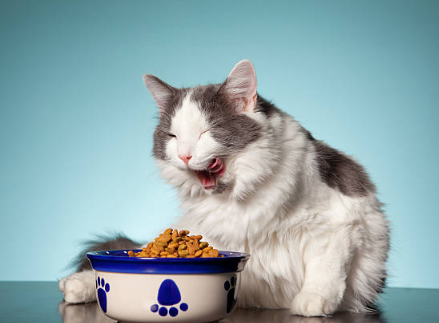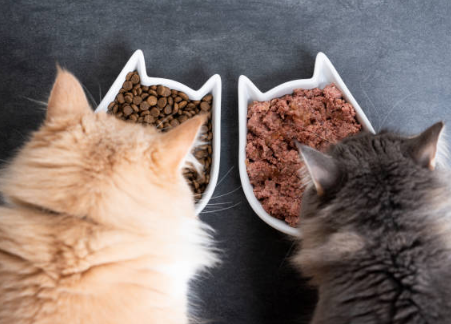Cats and humans have maintained a mutually beneficial relationship for about 12,000 years. People developed agriculture, which attracted pests, and felines were happy to act as pest controls. The role of cats in human society and their subsequent adaptation and domestication provide important clues for your pet cat to choose the best food.
10 Tips for Choosing Cat Food
1. Consider Your Pet’s Life Stage
The American Association of Feed Control Officials (AAFCO) is the brain behind FDA pet food regulation. One of the requirements for manufacturers is the life stage of the animal. That’s where we have to start. All products are not created the same. Kittens have different nutritional needs than adult cats. For example, the former must get more protein and certain vitamins and minerals to support growth.

Tip: Look for phrases that are “complete and balanced” to ensure your pet is getting proper nutrition.
2. Consider the Cat’s Ideal Weight
The 73 breeds recognized by the International Cat Association vary in weight, from petite Singaporean cats to huge Maine. Just like all foods are different, so are all pets. If possible, we recommend that you ask to see your parents when you buy your pet to know the cat’s adult size. Make sure to transition to adult food to avoid overfeeding your pet.
Tip: Consult your veterinarian to determine the ideal weight for your kitten.
3. Don’t Forget About Your Cat’s Activity Level and Lifestyle
Cats vary in activity levels, and many cats adjust their schedules to suit the needs of the family. An active feline like an Abyssinian cat may need more food than a lap cat like a ragdoll. Still, play is essential to bond with your kitten and provide an important enriching life. Even one hour of exercise a day can have a profound impact on your cat’s health.
Tip: Interactive games and playtime can improve your pet’s physical and mental health by increasing their activity.

4. Consider Any Allergies
Fortunately, food allergies and intolerances in cats are relatively rare. Chicken, beef, and dairy are the most common triggers. Gastrointestinal issues, itching, and hair loss are signs of possible allergies. However, these signs are not diagnostic. If you notice anything unusual, talk to your veterinarian about possible treatment options. This could be something your pet is eating.
5. Know Pet Food Labels
Manufacturers must provide nutritional information and feeding instructions for their products. It’s helpful to know what everything means so you can make an informed choice. The ingredient list starts with the ingredients that weigh the most and then descends from that point. Labels must contain a nutritional analysis, including protein and calorie percentages per serving.
6. Research Your Options
When it comes to deciding on cat food, you’ll find plenty of options. Keep in mind that an advertiser is trying to sell you a product with a description that sounds interesting. Vitamins and minerals are often included in their chemical names. If you’re not sure what something is, look it up and find out for peace of mind.

7. Dismiss Misleading Marketing Claims
The humanization of the pet industry has opened the floodgates for sketch marketing propositions. For example, as indicated on the label, the FDA does not currently define “human grade” and “natural.” If there is no scientific evidence to back it up,”proven” is also a loading word. We recommend sticking to the facts and putting aside nonsense.
8. Think About Your Pet’s Feeding Schedule
Convenience is the selling point of some products. It’s easier to pour out a portion of kibble than to open the can and pour it out while feeding. However, we recommend that you schedule your cat according to a schedule so that it will be easier for everyone involved to achieve the desired goals. Some cats prefer to graze throughout the day instead of eating at a set time, which is usually fine, as long as you measure their food so they don’t overeat.
Tip: Even if you feed your cat dry food for free, measure out your cat’s food.
9. Monitor the Cat’s Physical Condition
Monitoring your cat’s physical condition is essential as part of your daily care. When you look down on your cat, they should have a well-defined waist. It is important to note that feeding instructions are only recommendations and are not a clear guide to how much to feed your pet. A cat’s activity level plays an important role in the food they deserve.

Tip: Have a monthly vision exam to assess your pet’s weight and diet.
10. If There Is a Change, Reassess the Cat’s Needs
Changes often affect your pet’s intake and energy expenditure. Illness, weight gain, weight loss, and spaying or neutering can all affect how much you should feed your pet. This makes the previous steps essential for the cat’s health. For example, some cats are more likely to gain weight after being neutered, so a change in diet is required.
Tip: Keep an eye out for small things that can make a big difference, like snacks. They should only account for 10% of a cat’s caloric intake.
Final Thoughts
Choosing the right food for your cat is essential for good health. Fortunately, AAFCO and the FDA have taken significant steps to notify pet owners. Depending on the label and manufacturing requirements, comparative shopping becomes easier. Still, all pet owners should research their options and be skeptical of marketing claims. If you have any questions about the best food for your cat, your veterinarian will be happy to help.